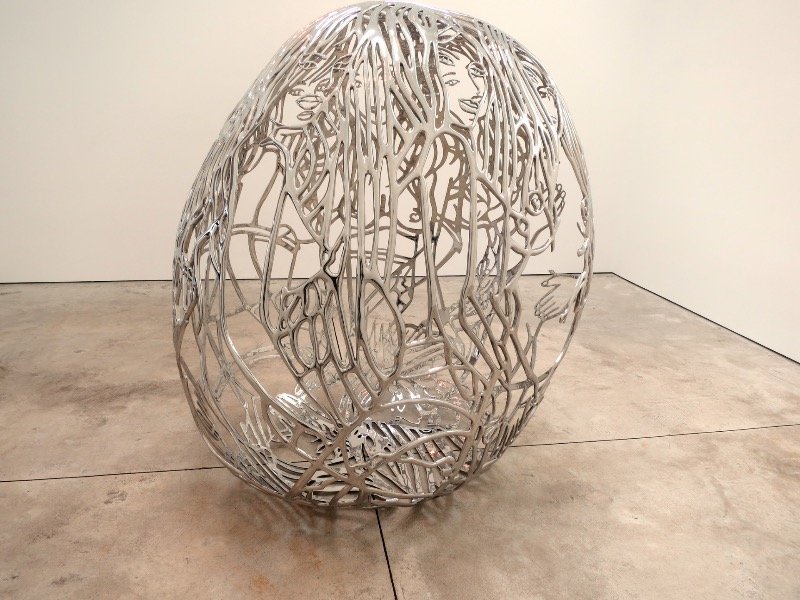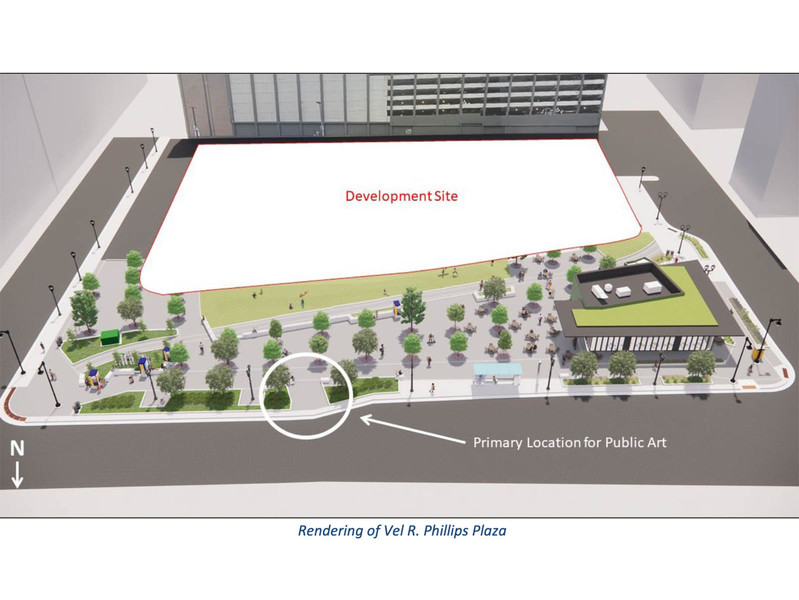Sculpture Milwaukee, a free outdoor urban sculpture experience in Downtown Milwaukee, has finalized its list of artists for the 2018 installation. Rounding out the list of featured artists are Egyptian artist Ghada Amer, British artist Richard Deacon and Serbian native Ana Prvački. Three works featured in the 2017 installation will be carried over into 2018. Those include works by American artist John Henry, American artist Sol LeWitt and Chicago-based artist Tony Tasset.
Sculpture Milwaukee will be on view from June to Oct. 21, 2018.
"Sculpture Milwaukee brings a new level of energy and excitement to the streets of Downtown Milwaukee," said Beth Weirick, CEO of Milwaukee Downtown, BID #21. "Once again, we’re delighted to activate our main street with works that will captivate Downtown residents, workers, students and out-of-town guests. We’re excited to host these works and put Downtown Milwaukee on an international art platform."
The newly released works include: Ghada Amer’s "Blue Bra Girls," 2012; Richard Deacons’s "Big Time," 2016; and Ana Prvački’s "Stealing Shadows, Michelangelo," 2007. John Henry’s "Zach’s Tower," 2007; Sol LeWitt’s "Tower (Gubbio)," 1996; and Tony Tasset’s "Mood Sculpture," 2017 will be carried over from Sculpture Milwaukee 2017.
These works will join Magdalena Abakanowicz’s "The Group of Five," 2014; Sanford Biggers’ "BAM (Seated Warrior)," 2017; Yoan Capote’s "Nostalgia," 2013; Tom Friedman’s "Hazmat Love," 2017; Liz Glynn’s "Untitled (Burgher with extended arm)," 2014; Gary Hume’s "Bud (bronze)," 2016; Jessica Jackson Hutchins’ "Reason to Be," 2017; Mel Kendrick’s "Marker #2," 2009; Shana McCaw and Brent Budsberg’s "Skew," 2018; Kiki Smith’s "Seer (Alice II)," 2005; Bosco Sodi’s "Untitled," 2017; Hank Willis Thomas’ "Liberty," 2015; Bernar Venet’s "97.5° Arc x 9," 2007; and Erwin Wurm’s "Half Big Suit," 2016, which were previously announced last month.
Led by Steve Marcus, chairman of the board of The Marcus Corporation, Sculpture Milwaukee is an annual gift to the community, bringing world-renowned works to an accessible and approachable environment for all to enjoy. From art connoisseurs and collectors, to school children and office workers, the installation will spark imaginations and activate Wisconsin Avenue. Sculpture Milwaukee 2018 is curated by Russell Bowman, an art advisor based in Chicago and former director of the Milwaukee Art Museum, and Marilu Knode, Sculpture Milwaukee’s project director and former director of Laumeier Sculpture Park in St. Louis.
Egyptian artist Ghada Amer is well known for her brightly colored, embroidered "paintings" in which depictions of women are stitched and sewn onto the canvas. Extra thread is left to hang from the images’ contours like drips and splashes of paint, abstracting and obscuring the figures. Amer slyly pokes at the clothing restrictions imposed on women in Islamic countries, suggesting ways in which women covertly integrate fashion into their lives in order to express their own personal style. By using the traditionally feminine, domestic activity of embroidery in a gestural manner to both decorate and hide her figures, Amer confronts cultural objectification of the female form. "Blue Bra Girls," 2012 is on loan courtesy of the artist and Cheim & Read, New York.
Richard Deacon is part of the post-war generation of British artists reacting to the now-classic works of Henry Moore, Sir Anthony Caro and Barbara Hepworth. Deacon, who calls himself a "fabricator," is known for experimenting with a range of traditional and non-traditional fine arts materials, from laminated wood, stainless steel, corrugated iron and polycarbonate to marble, clay vinyl, foam and leather. In "Big Time," 2016, we can trace Deacon’s interest in juxtapositions – flat versus round, manufactured versus hand-applied. Gravity and time are Deacon’s partners in this piece, the blotches of purple pain dripping from each bulbous end and meeting in the middle of the lozenge-like forms. His forms are often playful, reminiscent of real objects in the world, but through scale and material, shift how our bodies and minds respond to them. "Big Time," 2016 is on loan courtesy of the artist and the Marian Goodman Gallery, New York.
Throughout his career, John Henry has pursued a rigorous formal thinking that links his 1960s Minimalism to the experiments of Russian Constructivists of the early 20th century. His works balance delicate lines against sturdy trunks of steel, adding color as a way to stand out against the urban environments of the American landscape. In "Zach’s Tower," 2007, a piece carried over from Sculpture Milwaukee 2017, Henry balances delicate forms and buoyant lines against strong, leaden anchors. As with most three-dimensional sculpture, this piece evolves as the viewer walks around it. Henry’s work frames the geometries of our built environment, breaking down the outsize scale of skyscrapers and creating small vignettes. Vibrant and expressionistic against 100+ years of architectural history found in Milwaukee’s Downtown, his work enlivens the solidity of buildings with the invention of visual experiments. Positioned at the southeast corner of 5th Street and Wisconsin Avenue, "Zach’s Tower," 2007 is on loan courtesy of the artist, Chattanooga.
Artist, writer, philosopher and philanthropist Sol LeWitt created an enduring legacy as one of the founders of American Minimalism – a movement characterized by the use of a restricted range of mostly industrial, post-war building materials, in non-expressive shapes and muted colors. LeWitt was also an early pioneer and proponent of Conceptual Art – an ideas-based practice that uses the neutral systems of science and math to generate sculptures and wall drawings that could be made by others following his directions. In "Tower (Gubbio)," 1996 commissioned for the XXIII Biennale in Gubbio, Italy, LeWitt has removed his own artistic hand by using concrete blocks – a coarse building material that is part of our modern day urban environment, but also was a material used by the Romans to construct their cities. "Tower (Gubbio)," 1996 was constructed on-site at the corner of 4th Street and Wisconsin Avenue as part of Sculpture Milwaukee 2017 and will carry over into the 2018, courtesy of Pace Gallery, New York.
Ana Prvački finds our daily world an unparalleled stage for artistic interventions. She resists our obsession with material things and applies a playful touch to her critical thinking on how we allow objects to dominate our lives. Prvački has focused on different social norms regarding personal space; on the tangible influence of ephemeral music; and has invented all kinds of contraptions that celebrate the human capacity for invention of useless things. In "Stealing Shadows, Michelangelo," 2007, Prvački draws inspiration from Michelangelo’s world-renowned monument of David – the shepherd boy who defeats Goliath in the Old Testament by using a simple sling and rock. While Michelangelo elevates a commoner to the status of victor, David’s face is also wrinkled with concern. By presenting David’s shadow on the street, Prvački brings to us a monument of comfort and faith in the way we face the challenges of our own daily lives. Prvački's provocative appropriation also pokes at the long shadow this monument plays in establishing standards for public art. "Stealing Shadows, Michelangelo," 2007 is on loan courtesy of the artist and 1031PE, Los Angeles.
Over the past decade, Chicago-based artist Tony Tasset has been making surreal sculptures that draw imagery from American popular culture. Like Pop artist Andy Warhol before him, Tasset looks for images or ideas that are simple and easily understood, allowing the visitor to bring their own set of meanings to each work. In his totemic "Mood Sculpture," 2017, Tasset draws from the cheerful smiley faces, invented in 1963, to show the rainbow range of moods that afflict our days, from the sour grape face at the bottom to the Sunny Delight yellow face on top. His cheery, childlike colors remind us of how radical new ideas of the 1960s have today been packaged as consumer products. Positioned at 411 E. Wisconsin Ave., "Mood Sculpture," 2017 will carry over into the 2018 installation, courtesy of the artist and the Kavi Gupta Gallery, Chicago.
Installation of Sculpture Milwaukee 2018 will begin on May 10 along Wisconsin Avenue. All of the 20 art works by 21 artists, with the exception of one borrowed from a private collection, are available for purchase with a percentage of each sale going toward Sculpture Milwaukee’s future installations. An extensive range of tours, hands-on workshops and additional "avenue activation" activities will be held throughout the summer and fall. Additional info on Sculpture Milwaukee 2018 can be found at www.sculpturemilwaukee.com.







